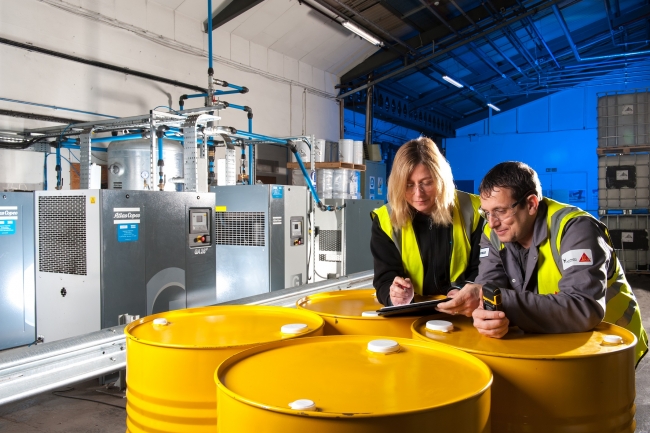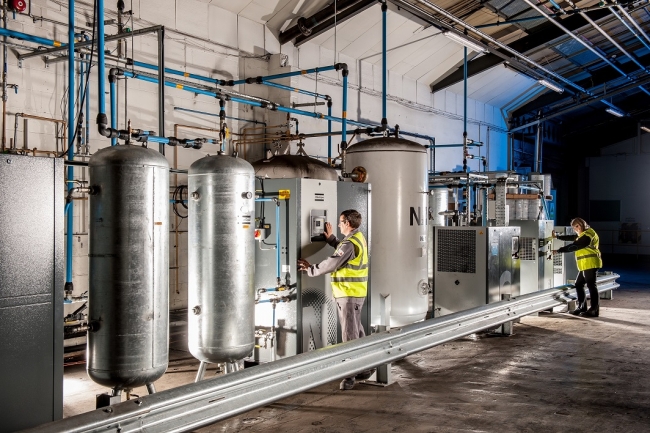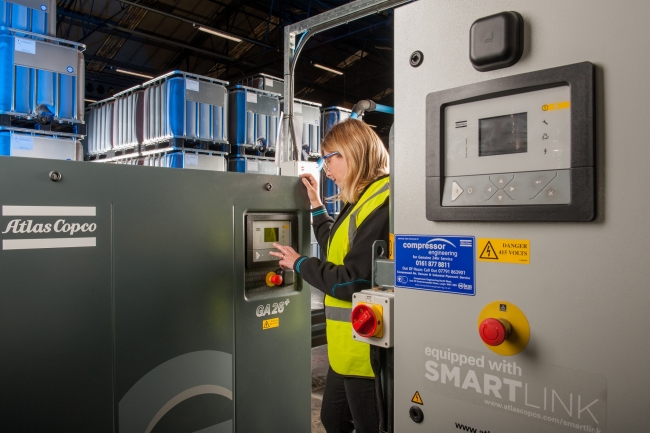4 minute read • published in partnership with Atlas Copco
How one chemical manufacturer improved productivity following site investment
Sika Limited is a part of the global Sika Group, specialising in the manufacture and supply of chemical based products serving construction and industrial markets. The company operates out of two manufacturing facilities and five sites including Ireland. The six-acre site in Preston, Lancashire is home to the production of Sika’s Liquid Applied Membrane products. Over the years, Sika has made significant investments in both plant and premises.
Recently, Sika Limited has virtually halved its batch transfer time after installing a centralised and remotely monitored compressed air and nitrogen system from Atlas Copco. The system, which was installed, and is being serviced, by Atlas Copco subsidiary Compressor Engineering, is proving essential in the safe and efficient production procedures at the company’s manufacturing facility in Preston, UK. Furthermore, it has allowed full centralisation between adjacent plant installations and provided capacity for expansion.

Sika has virtually halved its batch transfer time after installing a centralised and remotely monitored compressed air and nitrogen system / Picture: Atlas Copco
Dry compressed air and a supply of nitrogen are essential components of the batch mixing production process. Both gases are also used to top off the bulk containers of chemicals prior to sealing them before they are shipped to customers. Airflow is required for valve actuation and to feed the on-site nitrogen generators. The end products have a moisture sensitivity and require nitrogen to assist moisture management while, conversely, ensuring the liquid components aren’t susceptible to combustion. The overall role of these utilities is to maintain product quality and to provide a safe production environment.
In Sika’s production processes the batch mixing procedure for large volumes of liquid materials is conducted under vacuum in vessels with capacities in excess of 5,000 litres. Batch transfer operations involve removing the vacuum under a nitrogen atmosphere in equally large volumes. The new utilities system, with increased capacity, allows more rapid generation and availability of the blanketing gas. This ultimately reduces batch transfer times and virtually halves the transfer cycle duration; thus, improving productivity and the energy efficiency of the system.
There is an important safety consideration too. Much of the material involved within the process presents a flammable and explosive potential. The ready availability of nitrogen offsets that risk. At the same time, and in combination with a dry air supply, it helps to extend the lifetime of valves and solenoids while protecting them from corrosion, thereby minimising repair downtime.

The six-acre site in Preston is home to the production of Sika’s Liquid Applied Membrane products / Picture: Atlas Copco
The equipment upgrade programme was initiated after a review of the performance of the site’s entire compressed air and nitrogen system with a view to improving productivity. Following this internal assessment, it was decided that the original installation lacked the capacity to meet peak production demand in the future, with upgrades to the existing equipment deemed to be impractical due to the unavailability of spare parts. The fact that two separate compressor systems were competing with each other to achieve the required demand was also judged to be inefficient from an energy management perspective.
Following a decision to look for a new provider, responsibility for maintaining the existing system was transferred to Compressor Engineering who conducted an extensive iiTrak peak performance and flow monitoring exercise to determine the best solution for Sika’s production needs. The audit revealed the logical course of action was to centralise the two plant supplies and to replace all of the existing units.
Although potential energy savings alone provided justification for a new equipment purchase, the primary objective was to re-establish system reliability, ensure adequate back up capacity and deliver a high level of service. Lisa Baines, Operations Manager explained: “It was clear from the beginning that the old system could not cope in terms of capacity, quality or reliability. We also had to pay due regard to the power loading aspect as a cost component.”
The final recommendation was to install three Atlas Copco GA 26+ rotary screw, fixed-speed compressors. This was in addition to a GA30VSD+ variable speed drive unit equipped with a BD250 desiccant air dryer, ancillaries, filters and air receiver. Nitrogen production is provided via two NGP30+ generators with corresponding filtration and individual receivers. Both the compressors and the nitrogen generators were fitted with flow meters as an integral part of the system to help apportion costs between the conjoined sites and assist the remote monitoring operation.

The equipment upgrade programme resulted in improved site productivity and energy savings for Sika / Picture: Atlas Copco
The entire system is fitted with Atlas Copco’s SMARTLINK data monitoring programme, which intelligently gathers, compares and analyses data to increase maintenance and service efficiency. SMARTLINK provides Sika UK with a complete insight of its compressed air and nitrogen production, helps to predict potential problems and shows how and where operations can be optimised, and energy can be saved.
Lisa added: “Capacity, reliability, safety and productivity – every element of the operation has plus points.”
All components of the centralised compressed air and nitrogen supply are connected to two new ring mains comprised of AIRnet modular, corrosion resistant aluminium pipework and fittings. The whole system is protected under an Atlas Copco 5-year extended warranty service plan, carried out by Compressor Engineering.

